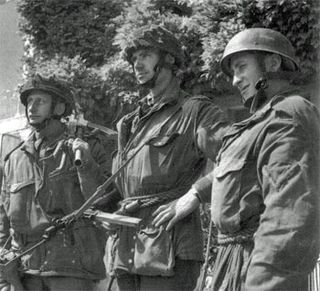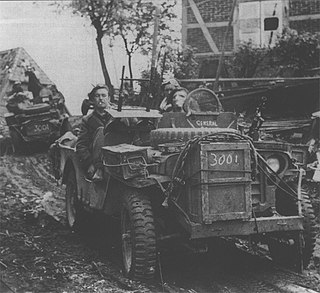Related Research Articles

The Special Air Service (SAS) is a special forces unit of the British Army. The SAS was founded in 1941 as a regiment, and later reconstituted as a corps in 1950. The unit undertakes a number of roles including covert reconnaissance, counter-terrorism, direct action and hostage rescue. Much of the information and actions regarding the SAS is highly classified, and is not commented on by the British government or the Ministry of Defence due to the sensitivity of their operations.

The Special Boat Service (SBS) is the special forces unit of the United Kingdom's Royal Navy. The SBS can trace its origins back to the Second World War when the Army Special Boat Section was formed in 1940. After the Second World War, the Royal Marines formed special forces with several name changes—Special Boat Company was adopted in 1951 and re-designated as the Special Boat Squadron in 1974—until on 28 July 1987 when the unit was renamed as the Special Boat Service after assuming responsibility for maritime counter-terrorism. Most of the operations conducted by the SBS are highly classified, and are rarely commented on by the British government or the Ministry of Defence due to their sensitive nature.

The 1st Airborne Division was an airborne infantry division of the British Army during the Second World War. The division was formed in late 1941 during World War II, after the British Prime Minister, Winston Churchill, demanded an airborne force, and was initially under command of Major-General Frederick A. M. Browning. The division was one of two airborne divisions raised by the British Army during the war, with the other being the 6th Airborne Division, created in May 1943, using former units of the 1st Airborne Division.

The 6th Airborne Division was an airborne infantry division of the British Army during the Second World War. Despite its name, the 6th was actually the second of two airborne divisions raised by the British Army during the war, the other being the 1st Airborne Division. The 6th Airborne Division was formed in the Second World War, in mid-1943, and was commanded by Major-General Richard N. Gale. The division consisted of the 3rd and 5th Parachute Brigades along with the 6th Airlanding Brigade and supporting units.

The Artists Rifles is a regiment of the British Army Reserve. Raised in London in 1859 as a volunteer light infantry unit, the regiment saw active service during the Second Boer War and the First World War, earning a number of battle honours. It did not serve outside Britain during the Second World War, as it was used as an officer training unit at that time. The regiment was disbanded in 1945, but in 1947 it was re-established to resurrect the Special Air Service Regiment. Today, the full title of the Regiment is 21 Special Air Service Regiment (Artists) (Reserve) and with 23 Special Air Service Regiment (Reserve), it forms the Special Air Service (Reserve).
Steven J. Zaloga is an American author and defense consultant. He received a bachelor's degree cum laude at Union College and a masters degree at Columbia University, both in history.

The Special Forces Support Group (SFSG) is a unit of the British Armed Forces. The SFSG is the newest addition to the United Kingdom Special Forces. It was formed officially on 3 April 2006 to provide specialist infantry and other support to the Special Air Service, the Special Reconnaissance Regiment and the Special Boat Service on operations. The 1st Battalion Parachute Regiment, a company strength group of Royal Marines, and a company of RAF Regiment personnel from No. II Squadron RAF Regiment as well as JTAC's and TACP's from the RAF Regiment form the UK's Special Forces Support Group (SFSG). The SFSG may provide extra firepower from land or air to fulfil their mission.

Operation Titanic was a series of military deceptions carried out by the Allied Nations during the Second World War. The operation formed part of Operation Bodyguard, the cover plan for the Normandy landings in 1944. Titanic was carried out on 5–6 June 1944 by the Royal Air Force and the Special Air Service. The objective of the operation was to drop 500 dummy parachutists in places other than the real Normandy drop zones, to deceive the German defenders into believing that a large force had landed, drawing their troops away from the beachheads and strategic sites such as Caen.

The 1st Marine Infantry Parachute Regiment is one of three regiments in the French Army Special Forces Command.
The History of the British Army's Special Air Service or SAS regiment begins with its formation during the Western Desert Campaign of the Second World War, and continues to the present day. It includes their early operations in North Africa, the Greek Islands, and the Invasion of Italy. They then returned to the United Kingdom and were formed into a brigade with two British, two French and one Belgian regiment. The SAS Brigade then conducted operations in France, Italy again, the Low Countries and finally into Germany.
Director Special Forces (DSF) is the senior British Armed Forces officer responsible for special forces. The post is a senior role within the Ministry of Defence (MoD). As Director, the incumbent is responsible for the provision of United Kingdom Special Forces capability to MoD, and holds Operational Command for discrete Special Forces operations.

The 3rd Battalion, Parachute Regiment, is a battalion sized formation of the British Army's Parachute Regiment and is a subordinate unit within 16 Air Assault Brigade.
Operation Bulbasket was an operation by 'B' Squadron, 1st Special Air Service (SAS), behind the German lines in German occupied France, between June and August 1944. The operation was located to the east of Poitiers in the Vienne department of south west France; its objective was to block the Paris to Bordeaux railway line near Poitiers and to hamper German reinforcements heading towards the Normandy beachheads, especially the 2nd SS Panzer Division – Das Reich.

Operation Houndsworth was the codename for a British Special Air Service operation during the Second World War. The operation carried out by 'A' Squadron, 1st Special Air Service between 6 June and 6 September 1944, was centred on Dijon in the Burgundy region of France. Their objective was to disrupt German lines of communication, coordinate the activities of the French Resistance and prevent German reinforcements moving to the Normandy beachheads, especially the 2nd SS Panzer Division Das Reich.

Special forces and special operations forces (SOF) are military units trained to conduct special operations. NATO has defined special operations as "military activities conducted by specially designated, organized, trained, and equipped forces, manned with selected personnel, using unconventional tactics, techniques, and modes of employment".

The 156th Parachute Battalion was an airborne infantry battalion of the Parachute Regiment raised by the British Army during the Second World War.
The British Armed Forces award a range of Parachutist Badges to those qualified as military parachutists. The version awarded depends largely on the unit or role that the individual fills following qualification.

Ernest Thomas "Bob" Lilley M.M., B.E.M. was a British Army soldier. A founding member of the British Special Air Service Regiment, he formerly served with the Coldstream Guards. Lilley was one of the first four men selected by Colonel David Stirling to comprise L Detachment 1st S.A.S. in Middle East Headquarters at Cairo in 1940. He took part in many operations behind enemy lines in Libya against Italian and German forces during World War 2.
Operation Trent was an operation by Special Air Service (SAS) elements of the British Army, the largest known post-WWII operation in SAS history. The operation was carried out by members a regimental task group, made up of a tactical HQ, members of A Squadron and G Squadron of the 22nd Special Air Service Regiment, supported by United States (US) forces, on an al-Qaeda-linked opium plant during the 2001 invasion of Afghanistan at the start of Operation Enduring Freedom – Afghanistan (OEF-A).

Operations Wallace and Hardy also known separately as Operation Wallace and Operation Hardy were the codenames for two British Special Air Service operations during the Second World War that took place from 27 July to 19 September 1944. Initially two sets of operations by 2nd Special Air Service, they were eventually amalgamated into one. Their objective was to disrupt German lines of communication, coordinate the activities of the French Resistance and prevent German reinforcements moving to the Normandy beachheads.
References
- ↑ "International Bodyguard Association - History". ibabodyguards.com. Archived from the original on 31 July 2012. Retrieved 6 February 2009.
- ↑ "I.B.A. Deutschland - International Bodyguard Association". www.iba-deutschland.de. Retrieved 25 June 2016.
- ↑ Lewis, Jack; Campbell, Robert K.; Steele, David (2007). "The Combat Training Team". The Gun Digest Book of Assault Weapons (7th, illustrated, revised ed.). Gun Digest. p. 129. ISBN 0-89689-498-3.
- ↑ White, Terry (2007). "Acknowledgements". The SAS Fighting Techniques Handbook. Globe Pequot. p. vii. ISBN 1-59921-081-9 . Retrieved 28 May 2017.